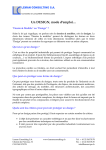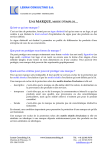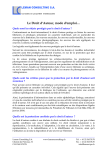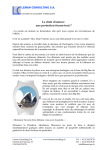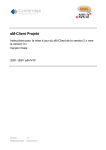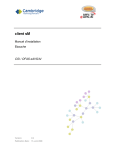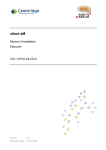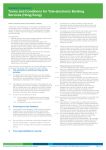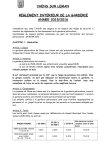Download TRADEMARKS, A USER'S GUIDE…
Transcript
TRADEMARKS, A USER’S GUIDE… What is a trademark? A trademark is a protective title, formed by a distinctive sign such as a name or a logo, and which gives the owner the exclusive right to use the sign for defined goods or services. The purpose of this distinctive sign is to allow the public to distinguish the goods of one business from those of its competitors. What can be protected by a trademark? A trademark can be protected in the following forms: verbal (a single word), figurative (a logo on its own), combined (a logo and a name) or in the form of a slogan, a jingle, a threedimensional shape or a colour. In order to be able to be protected, a trademark has to be capable of being represented graphically. Can identical trademarks coexist? Yes. By virtue of the principle of speciality, identical or similar trademarks can coexist provided that they concern different goods or services and that there is no likelihood of confusion between the trademarks. This involves each trademark being filed and protected for clearly defined goods and/or services. Goods are arranged in 34 classes (classes 1 to 34) and services in 11 classes (classes 35 to 45). It should be noted that the likelihood of confusion between two trademarks is evaluated by comparing the similarities and not the differences between the two trademarks. These similarities can be graphical (two similar logos), phonetic (Light, Lite) or intellectual (White Horse, Cheval Blanc). What are the criteria for obtaining trademark protection? For a trademark to be capable of being protected, it must not be excluded from protection by the absolute grounds for refusal or the relative grounds for refusal which are defined by law. A trademark is excluded from protection according to the absolute grounds for refusal if it is: − descriptive i.e. the trademark itself describes the nature, intended purpose or origin of the goods and services. Leman Consulting S.A. Chemin de Précossy, 31 CH-1260 NYON www.lemanconsulting.ch Tel. + 41 22 363.78.78 Fax + 41 22 363.78.70 [email protected] 2 − deceptive i.e., on seeing the trademark, the consumer expects the goods to have a specific quality, origin or properties, but in reality these do not exist for the goods in question. − banal i.e. the trademark does not have any distinctive imaginative features. In short, an important condition to allow a trademark to be protected is that it is imaginative. A trademark is excluded from protection according to the relative grounds for refusal if it is similar or identical to a previously filed trademark for similar or identical goods or services. How should you choose a trademark ? Before using or filing a trademark, it is prudent to ensure that its use will not be prohibited on the basis of the aforementioned grounds of exclusion. When the trademark is defined, several variants should be chosen, for example 4 or 5, of an imaginative name, that is neither descriptive nor deceptive. A search should be made on the basis of these 4 or 5 variants in the trademark registers of the main countries in which protection is envisaged. This search will determine whether similar prior trademarks exist and allow the variant with the least likelihood of confusion with another trademark to be chosen. The search thus minimizes the likelihood of the trademark being revoked by a third party who has registered a similar trademark, and that third party then prohibiting use of the trademark. The search is important from various points of view. First of all, each trademark filing gives rise to the payment of official fees. These fees are not reimbursed if the trademark is revoked or not accepted for registration. Moreover, the trademark is often an essential communication medium for a business. Communication occurs by means of printed matter, brochures, packaging, articles and other publications. Changing a trademark of course means reprinting all of these items. The trademark is also meant to create an image of the company or the product. Acquiring an image generally takes time and is expensive. Any investments made are also lost when a trademark is changed. It should be noted that many trademark offices do not check for the existence of prior rights which could object to the registration of a trademark on relative grounds of exclusion. These grounds of exclusion can however be cited by a prior right owner in order to prohibit any use of the trademark, in whatever form. It is thus highly recommended to check the availability of the trademark before reaching a final choice. When should the trademark be protected? A trademark can be used, then subsequently filed. However, the right to the trademark belongs to the first party to file it and not to the first party to use it. It is thus of paramount importance to file the trademark sufficiently early, particularly before investing heavily in it, so that a third party cannot appropriate it. © Leman Consulting S.A. 2002-2012 3 Further, if the filing is made at an early stage, any conflict with a prior trademark will be detected more quickly and any alteration that has to be made to the trademark because of the existence of +a prior right will not necessarily involve significant losses. What does a trademark registration application contain? A trademark registration application contains three distinct parts. First of all, it indicates the trademark owner’s details. It also contains a representation of the sign for which protection is sought. Finally, it contains a list of the goods and services associated with the trademark. Which countries should be covered ? With the exception of the Community trademark, which is protected throughout the European Union by means of a single registration application, it is only possible to obtain protection by applying to the national office of each country in which the applicant is interested. No worldwide trademark exists. A convention linking more than 160 countries (the Paris Convention) recognizes, however, a right of priority for the first registration application for a determined trademark made in one of the signatory countries, provided that an application for the same trademark is filed in one or several other signatory countries within 6 months of the first application date. This six month period (priority period) allows the economic interest of the trademark to be evaluated before expenses are incurred in extending protection. Despite the absence of a worldwide trademark, there exists a simplified procedure for applying for international registration of a trademark, which enables several countries to be covered in a single application. However, each of the countries thereby designated retains the right to refuse protection for the international trademark in its territory (see page 4 « Filing an international registration application under the Madrid Agreement or Madrid Protocol). Maintaining a trademark in force The term of trademark protection varies from country to country, but in most countries, it is 10 years. Protection can, however, be renewed indefinitely subject to payment of a renewal fee. Numerous countries require the trademark to be used in order for protection to be maintained. Proof of use may be required, particularly in the form of packaging or advertising. It can thus be important to keep such proof of use during the entire lifetime of the trademark. Administrative steps First filing © Leman Consulting S.A. 2002-2012 4 The most common way of protecting a trademark consists in filing a registration application in the country in which the owner has business activities or where the head office of his business is located. The date of filing in that country constitutes the date of the start of protection. Extensions In order to protect the trademark in other countries as well as the original country, several routes are possible, depending upon the countries. These routes are: − filing an international trademark under the Madrid Agreement or Madrid Protocol, − filing a Community trademark, or − filing national trademarks. Filing an international trademark under the Madrid Agreement or Madrid Protocol Original trademark Prior to any international filing, there must be a national trademark. This trademark must be filed in the country in which the business is commercially active or in the country of origin or residence of the owner. In most cases, the original trademark must be duly registered by the Office of the country of origin. It must, therefore, have successfully passed the various stages of the registration procedure. In order to benefit from the right of priority, registration must have occurred within a maximum period of 6 months from the first filing date. It is possible, where necessary, to request the procedure to be speeded up in order to increase the likelihood of meeting this deadline. International trademark By means of a single procedure, trademark protection can be sought for the group of signatory countries to the Madrid Agreement or Madrid Protocol by filing an international trademark. Once the trademark is registered, the effect in each country is the same as that of national registration. It is possible to designate one or several selected countries from the list of countries party to these treaties (see the attached list). This route is only available if an original trademark already exists as defined above. Advantages and drawbacks of the international trademark The costs generated by filing an international trademark depend on the number and nature of countries designated upon filing. However, generally, these costs are low in comparison to those of national filings. The larger the number of designated countries, the greater the difference in cost between an international filing and national filings. Moreover, for an international filing, it is possible, at any time, to designate countries that were not designated when the initial application was filed. The drawback of international filing arises from the fact that, first of all, it is necessary particularly for Swiss applicants – to obtain registration of the trademark in the country of © Leman Consulting S.A. 2002-2012 5 origin before filing an international trademark, and secondly, the international trademark is dependent on the original trademark for five years. This means that if the office of origin refuses to register the trademark, for example because it is considered descriptive or deceptive, it will not be possible to obtain protection via an international trademark, even if the trademark is not considered descriptive or deceptive in a number of other countries. Further, if the original trademark is revoked or the list of goods and services is restricted, the international trademark will suffer the same fate for the five year dependency period. However, it is still advantageous to use the Madrid system rather than filing national applications in all the countries in which the owner is interested. Indeed, the flexibility of the international filing procedure allows the owner of an international trademark to obtain “à la carte” protection by means of a single registration application. Moreover, as his business develops, the trademark owner can at any time designate new countries without having to start the filing procedure again from scratch. Currently, the Madrid system covers 80 countries/territories, including the United States and the European Union. Filing an international trademark application is a common procedure leading to a range of national trademarks. Maintaining the trademark in force in each of the countries therefore means that the trademark must be used in each country. Filing a trademark in the European Union The Community trademark covers the 27 states of the European Union. It is unitary in the sense that it is no longer one state that grants the trademark, but the central office based in Alicante (Spain). The trademark takes effect in 27 European countries and unlike the international registration, it is not possible to designate only part of the member countries. All of the countries are automatically covered. Advantages and drawbacks of the Community Trademark The major advantage of the Community trademark lies in the fact that the procedure includes a single examination of the trademark acceptance criteria. These criteria, and particularly the application thereof, do not depend upon the practice of each national office. Another advantage lies in the fact that it is not necessary to prove that the trademark is used in each of the countries of the European Union. Use in only one country is valid for all the others. As a corollary, the main drawback is that a pertinent priority only has to exist in one of the European Union countries for the priority owner to validly object to registration of the trademark. This is why we recommend conducting a priority search in all of the European Union countries before starting the Community trademark filing procedure. National trademark This route is the only one possible for obtaining protection in those countries that are neither members of the European Union nor signatories to the Madrid Agreement or Madrid Protocol. © Leman Consulting S.A. 2002-2012 6 This route is also used when the trademark is not accepted for registration in the country of origin, which prevents filing of an international trademark, or when a priority exists in a European Union country, which prevents registration of a Community trademark. Overview of the procedure Start date Swiss first filing 6 month Community filing (European Union) Madrid Union (Choice of countries) Others : Canada (No choice of country) Germany Benelux France …… Great-Britain Japan United States European Union © Leman Consulting S.A. 2002-2012






